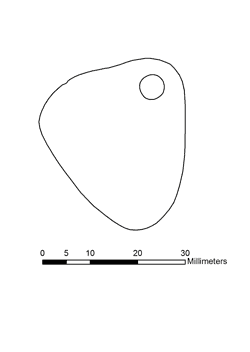Star Carr Pendant facts for kids
Quick facts for kids Star Carr Pendant |
|
|---|---|

Star Carr Engraved Pendant
|
|
| Material | Shale |
| Discovered | 2015 Star Carr, North Yorkshire 54°12′51″N 00°25′24″W / 54.21417°N 0.42333°W |
| Discovered by | University of York |
| Present location | Yorkshire Museum |
Imagine finding a tiny, ancient piece of art! The Star Carr Pendant is a special stone pendant found at an old settlement called Star Carr in North Yorkshire, England. It's made from a type of rock called shale. Experts say it's the oldest piece of art from the Mesolithic period (also known as the Middle Stone Age) ever found in Britain. This makes it a super important discovery!
Contents
Finding the Ancient Pendant
When Was the Star Carr Pendant Found?
This amazing pendant was discovered in 2015. A team of archaeologists from the University of York was carefully digging at the Star Carr site. The dig was led by a professor named Nicky Milner.
Who Found the Pendant?
A student named Tom Bell, who was studying at the University of Chester, was the lucky person who found it. He discovered the pendant during the very last days of the excavation. It was found near what used to be the edge of an ancient lake called Lake Flixton. Finding it in its original spot, or "context," helps archaeologists understand its history.
What Does the Pendant Look Like?
Size and Material of the Pendant
The Star Carr Pendant is shaped a bit like a triangle. It's quite small, measuring about 31 millimeters (just over an inch) long, 35 millimeters wide, and 3 millimeters thick. That's about the size of a large postage stamp! Scientists used a special test called ED-XRF to confirm it's made from shale, a dark, layered rock.
Engravings and Features
The front of the pendant has many lines carved into it. These lines run parallel to each other and often cross over. There's also a small hole drilled through one of its corners. This hole was made from the side with the engravings, probably so it could be worn as a necklace. On the back, there's a small chip where a piece of shale broke off. This might have happened by accident, or maybe someone hit it on purpose before it ended up in the lake.
Why Is This Pendant So Important?
Britain's Oldest Mesolithic Art
The Star Carr Pendant is truly one-of-a-kind. It's the earliest known example of art from the Mesolithic period in Britain. While similar pendants have been found in other parts of northern Europe, most of those are made from amber, not shale. This makes the Star Carr pendant extra special.
Understanding Its History
Unlike many other ancient finds, this pendant was found exactly where it was left thousands of years ago. This "archaeological context" helps experts learn more about the people who made and used it. Researchers believe the markings on the pendant might have been added in two different stages. This means more than one person might have worked on it over time.
What Do the Markings Mean?
People have many ideas about what the engravings on the pendant represent. Some think it looks like a tree, a map, or even a leaf. Others suggest the lines could be tally marks, used for counting. One interesting idea is that it might even show the wooden platforms that have been found at the Star Carr site. It's a mystery that makes the pendant even more fascinating!
Where to See the Star Carr Pendant
If you want to see this amazing piece of ancient art, you can find it at the Yorkshire Museum. It first went on public display in February 2016, and it's been a popular exhibit ever since!

